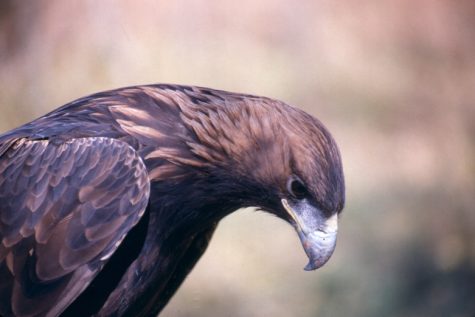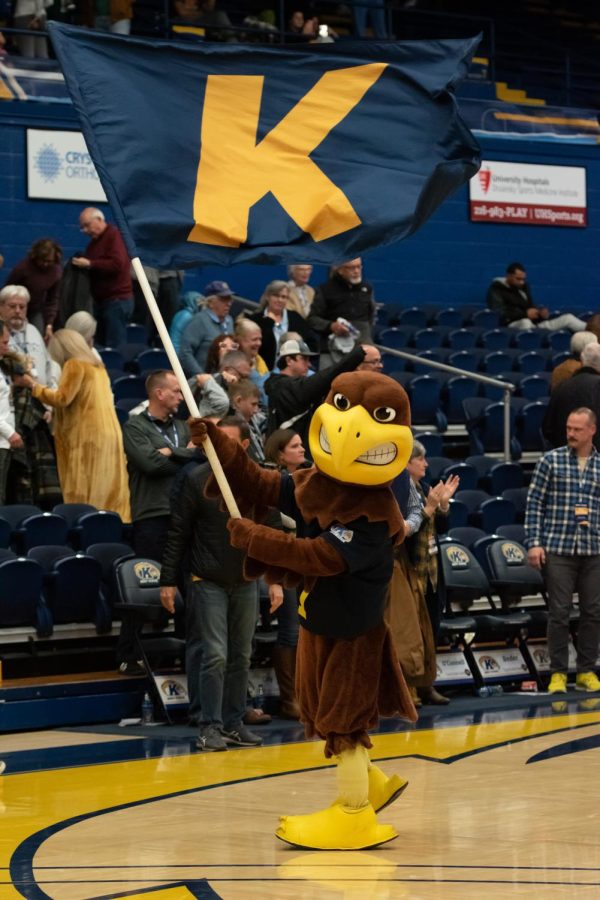The eagle behind the flash
Flash the Golden Eagle waves a flag to celebrate the men’s basketball team’s victory over Portland University on Nov. 14, 2022.
June 26, 2023
On Oct. 12, 1985, a live golden eagle made its debut as Kent State’s first official mascot at a homecoming football game against the University of Texas at El Paso.
The school unveiled the eagle, nicknamed “Flash,” who was held on the arm of his handler, Earl Schriver Jr. of Baden, Pennsylvania.
Today, a different golden eagle, the costumed mascot of the same name, continues to entertain fans at Kent State sporting events each year.
Throughout the years, Kent State went through a number of mascots before settling on the eagle. Kent’s first mascot was a silver fox.
When the school was still known as Kent State Normal College in 1923, a silver fox was chosen based on the school’s first president, John Edward McGilvery, who owned a silver fox ranch.
The school’s nickname became the Golden Flashes in 1926. In the fifties, a golden retriever was chosen as the mascot. Later, it was replaced by the comic character “Grog” and a lightning-inspired superhero referred to as “Freddie Flash.”
When finally introduced in 1985, the golden eagle mascot was meant to represent pride for the university. For Laura Edmunds, master falconer at Indiana Raptor Center, these birds represent much more.

Edmunds said she connects with birds at the raptor center every day, particularly Mariah, a disabled 38-year-old golden eagle who was hit by a car at age 29. She described how she interacts with the eagle.
“I get up close to her and I start very gently scratching the back of her neck and then she will bow,” she said. “That does two things: that’s a greeting, and they’re recognizing you and showing some trust in you.”
Edmunds has worked with birds for over 30 years and joined the Indiana Raptor Center in 2003. As someone who works personally with a golden eagle at the center, she has intimate knowledge of their behaviors.
She is touched by her work with golden eagles. She said that even though they are fierce predators, they know to trust her as a caretaker and source of food.
“At any time, that bird could turn around and take out part of my leg or bite me and they don’t,” she said. “It’s not because they have any affection towards you, but it would be stupid of them to to kill their food provider.”
Unlike bald eagles, golden eagles are land predators and prefer to hunt in open land near mountains and hills. They are typically found in the Western United States.
Edmunds described their hunting behaviors in this environment.
“They are pursuit birds and what they do is they will still on a ridge or cliff and they’ll look around for something they might want to eat,” she said. “Their vision is so good that they can see a jackrabbit that’s moving at two miles [away] and one that’s still from one mile away.”
Golden eagles that live further north, such as in Canada and Alaska, are semi-migratory in order to find prey in the winter.
Like many birds of prey, golden eagles typically mate for life and lay one to four eggs at a time.
In addition to their behaviors in the wild, Edmunds said golden eagles have distinct personalities compared to other birds.
“The bald eagle, if you piss them off, they’re going to do something about it right there,” she said. “A golden eagle on the other hand, if something has been done to them they’re going to pout about it and think about it and they’re going to scheme.”
She said that even weeks later, a golden eagle may remember and hold a grudge.
In good conditions, golden eagles can survive into their 40s, but an average lifespan is typically 20 years. Some factors preventing them from living longer are availability of food in the wild and habitat loss due to human interference.
“They fall in with an effort to try to save anything we can to get everything out there a prime place to live,” Edmunds said. “It’s getting more and more difficult to do.”
Golden eagles also only have a 30% chance of survival in the first year of their life, according to Edmunds.
While Kent State has had many mascots ranging from the silver fox to a golden retriever, the golden eagle has had staying power since its debut.
For Edmunds, there is no better mascot than a bird of prey.
“A golden eagle is a spectacularly intelligent bird,” she said. “They have compassion and they have a little bit of a sense of humor.”
She said these birds are always aware of their surroundings, she laughed when thinking about their awareness.
“When you spend enough time with these birds you notice that they notice you,” she said. “It’s so funny because as bird watchers, we’d go out here and we think we’re sneaking up on a bird, ha! That bird already knew you were there way before you even got close.”
Edmunds said her work with birds of prey has taught her many lessons over the years.
“They’re compassionate, intelligent beings,” she said. “They don’t eat, they don’t kill unless they’re hungry […] it’s an amazing thing to notice that they don’t take more than they need, and it’s a real lesson for us humans.”
Today, our feathered Flash competes with the black squirrel to represent the university, but in the eyes of someone so passionate about these creatures, there is only one true mascot.
Grace Springer is editor-in-chief. Contact her at [email protected].












